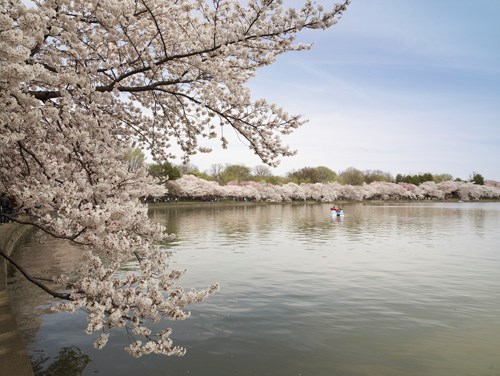Last updated: March 13, 2018
Article
Two Memorials and the Cherry Blossoms

NPS Photo
National Mall’s iconic memorials to Abraham Lincoln, Thomas Jefferson, and George Washington are influenced by Greek, Roman, and Egyptian art and architecture. However, the memorials to President Franklin Delano Roosevelt and civil rights leader Dr. Martin Luther King, Jr. are from a different era. These memorials reflect a more personal style, expressing each man’s unique characteristics and strengths. Both men died in the springtime, the same time that the cherry trees bloom. In this way, the cherry trees serve as a visual reminder that life, like the blossoms, is fleeting.
Japan’s 1912 gift of cherry trees to the people of Washington, DC and the United States was made in the spirit of peace and unity. Each spring the trees bring, with their brief, colorful blossoms, the hope of rebirth and renewal. Thousands of these trees dot the city, but the bulk reside along the Tidal Basin, especially around and within the Franklin Delano Roosevelt and Martin Luther King, Jr. memorials, where hanami, the act of viewing cherry blossoms, takes on an even more special meaning.
On April 12, 1945, less than three months after his fourth inauguration, President Franklin Roosevelt died suddenly. During his twelve years in office, through the devastations of the Great Depression and World War II, his unwavering confidence gave the American people a burst of energy and unifying momentum that not only rebuilt the country but also created a sense of community, enabling the country to move forward out of darkness.
Landscape architect Lawrence Halprin wanted to highlight at the Franklin Delano Roosevelt Memorial what it was like to live through FDR’s presidency, showcasing the influence he had on the nation and the world. Halprin’s original design was to be a straight line to demonstrate how Roosevelt’s presidency gave order to a disorderly time, but the random layout of the already-present cherry trees convinced Halprin to adapt to the trees. This change allowed Halprin to create a sense of physical and emotional choreography through the winding four “rooms” of the memorial, anchored by the more than 31,000 hand-cut stones that reflect the sharp turns of Roosevelt’s presidency. The memorial’s red granite makes it distinct from the white marble of surrounding memorials. In the springtime, the granite is highlighted by the blossoming pink cherry trees, making the memorial come alive with color and beauty, enticing the visitor to take a moment for contemplation.
Just around a bend in the Tidal Basin from Franklin Delano Roosevelt Memorial stands the memorial to Dr. Martin Luther King, Jr. The memorial was designed as a home to an additional 182 cherry trees, emphasising Dr. King’s lifelong message of endurance and faith. Most years, the blooming period of the trees coincides with the anniversary of King’s April 4, 1968 assassination. The color, light, and beauty of the cherry trees adds a sense of renewed hope to a time of reflection and remembrance. The blossoms add visual complexity to the varied stone surfaces of the memorial and underscores Dr. King’s messages of courage and leadership engraved throughout the memorial. The blossoms also highlight the shrimp pink granite of the centerpiece of the memorial, the statue of Dr. King set into the “Stone of Hope”, making King literally vibrant.
The cherry trees that decorate the Tidal Basin were not planted simply for their beauty. In Japanese history and culture, hanami, the viewing of cherry blossoms, is a tradition centered on appreciating the transient beauty of nature and the brevity of one’s own life, emphasizing the importance of making the most of what one has. This cultural symbolism is evident here at the National Mall as well. The trees entwined in the memorials to two great Americans are reminders to us that, though life is brief, it can be filled with beauty and meaning.
